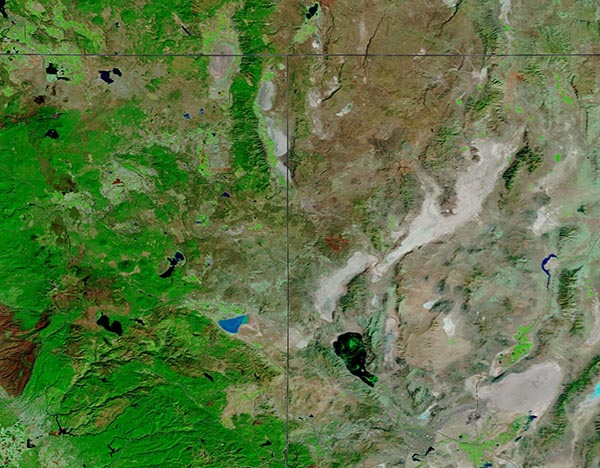Images
October 21, 2024 - Harmful Algae in Pyramid Lake
Tweet
Bright swirls of glowing green highlighted the otherwise dark waters of Pyramid Lake in mid-October 2024. The Moderate Resolution Imaging Spectroradiometer (MODIS) on NASA’s Aqua satellite acquired this true-color image of the spectacular colors on October 14.
The swirling colors were caused by dense bands of blue-green algae, also known as cyanobacteria. This western Nevada lake experiences similar blooms on a nearly annual basis, usually between August and September. Cyanobacteria is a group of microscopic organisms known to contain toxins that can cause health problems in people and animals.
The Pyramid Lake Paiute Tribe, which provides water quality assessments and report for the lake, noted on October 7 that that water conditions were favorable for increasing bloom activity , and that the lake water was becoming more opaque in some areas. Small spots of green were also noted by the MODIS on Aqua on October 6. The bloom continued to expand and discolor the water and likely reached its peak around October 15. After stormy weather passed over the region on October 16, Aqua MODIS showed little green color remained.
According to the Pyramid Lake Paiute Tribe, the autumn 2024 bloom contains the cyanobacteria Nodularia spumigena. Nodularia species are nitrogen fixers common in warm, brackish waterbodies. Recurring Nodularia blooms have been documented for decades in Pyramid Lake. This organism can produce toxins such as nodularin, which can affect the liver and cause other adverse health effects in humans. It may also bioaccumulate in aquatic vertebrates and invertebrates.
The Tribe reported on October 15 that the bloom was releasing toxins and advised people to avoid contact with the water. It may take two to three weeks from the peak of the bloom for water conditions to return to normal, they said.
Image Facts
Satellite:
Aqua
Date Acquired: 10/14/2024
Resolutions:
1km ( B), 500m (187.1 KB), 250m (396.2 KB)
Bands Used: 1,4,3
Image Credit:
MODIS Land Rapid Response Team, NASA GSFC
Tweet
Bright swirls of glowing green highlighted the otherwise dark waters of Pyramid Lake in mid-October 2024. The Moderate Resolution Imaging Spectroradiometer (MODIS) on NASA’s Aqua satellite acquired this true-color image of the spectacular colors on October 14.
The swirling colors were caused by dense bands of blue-green algae, also known as cyanobacteria. This western Nevada lake experiences similar blooms on a nearly annual basis, usually between August and September. Cyanobacteria is a group of microscopic organisms known to contain toxins that can cause health problems in people and animals.
The Pyramid Lake Paiute Tribe, which provides water quality assessments and report for the lake, noted on October 7 that that water conditions were favorable for increasing bloom activity , and that the lake water was becoming more opaque in some areas. Small spots of green were also noted by the MODIS on Aqua on October 6. The bloom continued to expand and discolor the water and likely reached its peak around October 15. After stormy weather passed over the region on October 16, Aqua MODIS showed little green color remained.
According to the Pyramid Lake Paiute Tribe, the autumn 2024 bloom contains the cyanobacteria Nodularia spumigena. Nodularia species are nitrogen fixers common in warm, brackish waterbodies. Recurring Nodularia blooms have been documented for decades in Pyramid Lake. This organism can produce toxins such as nodularin, which can affect the liver and cause other adverse health effects in humans. It may also bioaccumulate in aquatic vertebrates and invertebrates.
The Tribe reported on October 15 that the bloom was releasing toxins and advised people to avoid contact with the water. It may take two to three weeks from the peak of the bloom for water conditions to return to normal, they said.
Image Facts
Satellite:
Aqua
Date Acquired: 10/14/2024
Resolutions:
1km ( B), 500m (187.1 KB), 250m (396.2 KB)
Bands Used: 1,4,3
Image Credit:
MODIS Land Rapid Response Team, NASA GSFC




